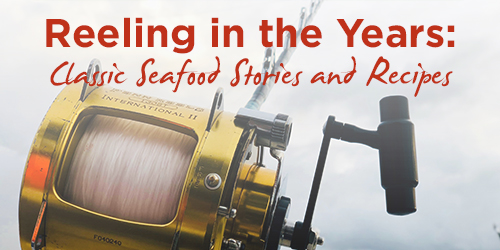Editor’s Note: Everything in this historical post is in the public domain.
By James Hoyt
You have been told so often how to plank a shad that it seems idle for me to talk about it at all. But there are planked shad and planked shad, and you know nothing of the properly prepared delicacy until you try it in the Thompson mode. The oaken planks use are thirty inches long, twenty inches wide and two and one-half inches thick. They are used over and over again, and the more frequently they are employed the better they become until they have been charred too much. A plank is first heated in an oven, and then the split fish is nailed to it and placed at a sharp angle before a brisk fire. It takes about half an hour to cook a six-pound shad, and during that time the board is frequently reversed from top to bottom, and the fish is basted almost continuously with the best gilt-edge butter. The latter operation requires the utmost care, for upon it depends much of the success of the planker.

“The prophetic eye of appetite” glistened expectantly as the fish, still upon the charred board, was placed upon the table. And say! wasn’t it delicious? Better than shad from anywhere else? Why, of course it was, you gillie. It must be confessed, however, that in these days of fast railroad transportation the Southern shad is not to be sneezed at. A few years ago, when they first came numerously into our market, they did not tickle the palate greatly. By the time they reached our kitchens the fish were too stale to be thoroughly sweet and enjoyable.
Nowadays, however, the Southern shad reaches this city the day after it is caught, and is not to be despised. Last February I ate planked North Carolina shad that was very delicious, but the meat lacked the firmness of our Delaware product. In fact, that is the defect of all Southern fish, the warmer waters of that region making the flesh flabby and soft. For that reason the Delaware shad will always excel in delicacy his Southern brother.
The former is absolutely incomparable, unless I except the shad of the upper Susquehanna. The fish caught at Columbia are, I think, slightly superior to those seined at Gloucester. The reasons for this are two-fold: In the first place the turbulent Susquehanna is crowded with fishways. Only the hardiest and finest fish can jump them, and consequently the prizes caught at Columbia fisheries make very small catches compared with those at Gloucester, and, having plenty of time on their hands, they cut the gills of each fish as it is caught and bleed it. They contend that this makes the meat much sweeter. There still lingers fondly in my memory the recollection of a fish treated in that way and served on Colonel Duffy’s hospitable table in his Marietta residence.
 Planking Shad, Maryland, 1890. Photographer unknown.
Planking Shad, Maryland, 1890. Photographer unknown.
But I have left that planked shad of Thompson’s on the dinner table, and if we don’t return to it, it will be cold, and cold fish is an abomination that all honest persons abhor. How did it taste? Well, if you have ever eaten planked shad at Washington Park, you know that no mortal ever possessed the gift to describe its gustatory charms.
Of course, some of you will curl your lips and sneeringly mutter, “bones.” Well, my dear children, I don’t wish to impair my character for veracity. Delaware shad don’t have any bones; at least they don’t appear to have any. A deft servitor, with a rapid movement of the knife and fork and a neat turn of the wrist, removes in a twinkling the backbone from the fish, and attached to it are nearly all the other needle-like splinters that infest the shad carcass. I assure you that movement of the Washington Park waiter is a revelation to a man who has choked on the secreted shad bone.







